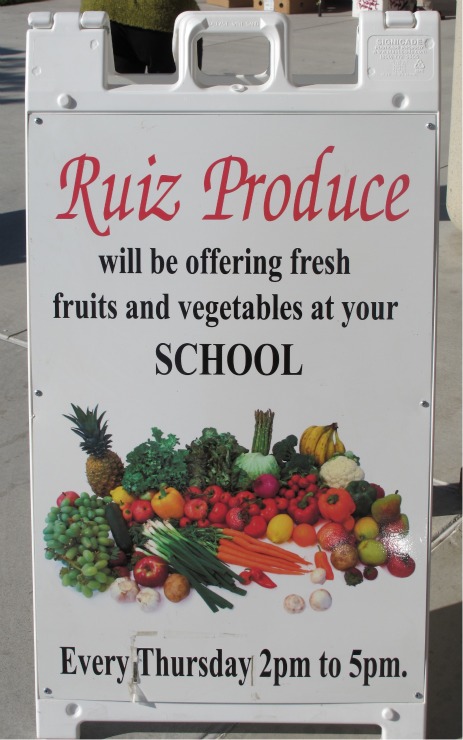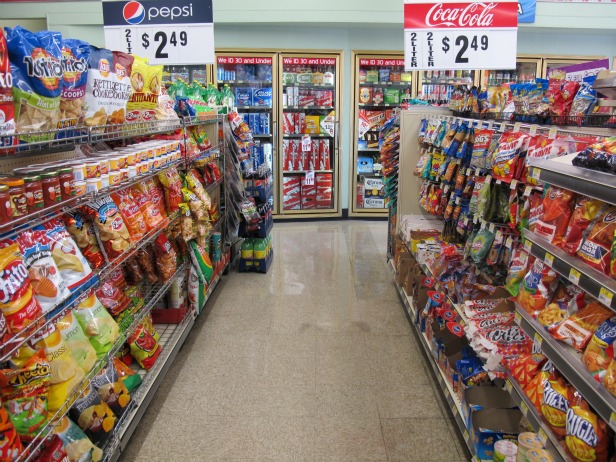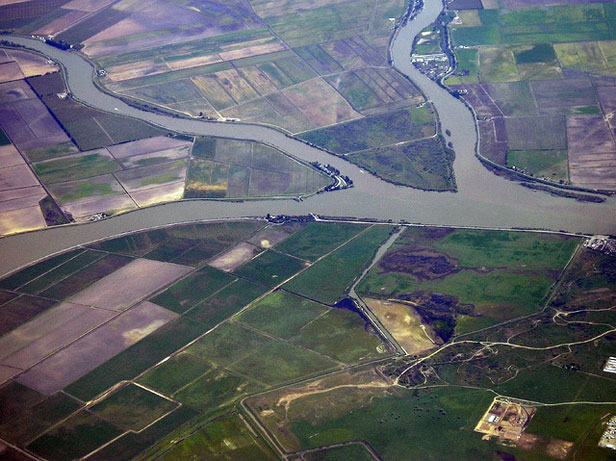 Green is the valley: Does this look like a desert to you?Photo: Bithead
Green is the valley: Does this look like a desert to you?Photo: Bithead
The produce stand looks like a typical farmers market booth, with a few women and men milling around looking at fresh-picked limes and rosy red tomatoes. But this market is also full of kids, lined up at a neighboring tent waiting for smoothies, and carrying off fruit cups as big as their heads.
“The first few weeks I forgot my money, and couldn’t get anything,” confides one excited elementary-school girl. “Now I get a smoothie after school every week. My mom makes me them at home for me now, too.”
 Ruiz Produce sign.Photo: Beth HoffmanEach Thursday, Ruiz Produce sets up this market outside Hildahl Elementary School to bring fresh food into the heart of Ceres, Calif., a heavily Hispanic community south of Modesto with little access to quality fruits and vegetables. One of three stands of its kind in the town, the Ceres Partnership for Healthy Children (CPHC) began the market this fall in an attempt to create a healthier environment for the area’s residents.
Ruiz Produce sign.Photo: Beth HoffmanEach Thursday, Ruiz Produce sets up this market outside Hildahl Elementary School to bring fresh food into the heart of Ceres, Calif., a heavily Hispanic community south of Modesto with little access to quality fruits and vegetables. One of three stands of its kind in the town, the Ceres Partnership for Healthy Children (CPHC) began the market this fall in an attempt to create a healthier environment for the area’s residents.
The Central Valley of California is said to produce half the fruits and vegetables grown in the United States, and yet it’s far easier to get a hamburger than a peach in most of the valley. Low-income residents have little access to fresh food as it is quickly and efficiently trucked off to cities and processing plants, returning back only as packaged, processed, and/or fast food.
Residents say the town of Ceres has many neighborhoods without a single shop in which to buy fruits and vegetables. Often the only place for those on tight budgets and limited transportation to shop are the fast food and convenience stores that dot the roadside, stocked with brightly colored chips and soda.
“Farmers from this area travel to Santa Cruz and San Francisco to sell their fresh produce because there are rich people there,” says a Latina mom of three from the town of Ceres, who requested anonymity. “Where are the farmers here to sell to us? We have nowhere to shop for fresh food.”
Cheap chips, expensive lettuce
“Food deserts” are a well-documented phenomena in urban areas like Oakland, Chicago, and Detroit. But rural areas too are experiencing a lack of access to fresh food, says the Center for Rural Affairs. In rural Kansas, for example, nearly one in five grocery stores has gone out of business in the last four years. (Read “Welcome to the Food Deserts of Rural America” for more.) It is likewise difficult to find a local apple or fresh lettuce in the middle of sparsely populated Iowa.
And although Ceres and the rest of the Central Valley are more densely populated than most of the Midwest, many residents are also unable to find reasonably priced food. The CPHC says the region has the highest rates of unemployment and food insecurity in the country: unemployment in Ceres is at 20.3 percent; in Stanislaus County, 16.4 percent.
 Brightly colored chips and soda fill the convenience stores.Photo: Beth HoffmanFarmworkers in the region are even more likely to be “food insecure” — a study [PDF] in late 2007 found that more than 42 percent eat less than three servings of fruits and vegetables a day, and in the winter months, 48 percent go hungry.
Brightly colored chips and soda fill the convenience stores.Photo: Beth HoffmanFarmworkers in the region are even more likely to be “food insecure” — a study [PDF] in late 2007 found that more than 42 percent eat less than three servings of fruits and vegetables a day, and in the winter months, 48 percent go hungry.
The result is that the residents of Ceres and the Central Valley in general are turning to cheap, calorie-dense but nutrient-poor foods — and are growing fatter. The area has significantly higher rates of overweight and obese adults (65 percent), seniors (63 percent), and children (15.5 percent) than the California state average (56, 56, and 14 percent respectively).
Marta Peña is one of those people. A part-time fruit-cocktail packer and mother of three who also lives Ceres, Pena explains she and her 16-year-old daughter are overweight because they eat too much fast food. “We like the tacos at Jack in the Box, and so I take my daughter there because that’s what she wants to eat,” she says, admitting, “I need to be stricter with what my kids are eating.”
Peña is up against a powerful industry with deep-pocketed persuasion campaigns. A recent study by the Rudd Center for Food Policy at Yale found that “fast food restaurants appear to disproportionately target African Americans and Hispanics with their marketing efforts … Fast food advertisements are prevalent on Spanish-language television networks, comprising nearly half of all ads.” The same study estimates the fast food industry spent more than $4.2 billion in 2009 on advertising targeted directly to kids. (For more on the study, see Tom Philpott’s November 2010 article in Grist.)
Likewise, a report by the California Center for Public Health Advocacy showed that in 2005 California had more than four times the number of fast-food and convenience stores than markets, with rural areas having as high as a 6 to 1 ratio.
“The store windows are covered in advertisements for soda,” complains another Ceres mom, standing in a convenience store surrounded by the greens, reds, and blues of candy wrappers and potato chips. “Even if these stores carried fresh fruit too, who would buy it?”
Cut the fat
 Ceres kids buying fruit at stand.Photo: Beth Hoffman“The paradox of our community is that we are growing food here, and yet there is not enough healthy food to eat,” says Maria Lourdes Perez, the program coordinator of Ceres Partnership for Healthy Children and a resident of Ceres. “The food is taken elsewhere.”
Ceres kids buying fruit at stand.Photo: Beth Hoffman“The paradox of our community is that we are growing food here, and yet there is not enough healthy food to eat,” says Maria Lourdes Perez, the program coordinator of Ceres Partnership for Healthy Children and a resident of Ceres. “The food is taken elsewhere.”
So these concerned Ceres parents have now teamed up with the Central California Regional Obesity Prevention Program (CCROPP) to try and create a healthier neighborhood for their families. Healthy eating is not just a question of individuals making better food choices, argues the CPHC, but of creating environments that support healthy living. The group focuses on improving food access for the community and in creating and maintaining safe places for kids and adults to recreate.
To this end, the CPHC has set up the farmers markets at schools, repaired sidewalks and parks, and launched what it calls the “walking school bus.” Parents trained in CPR and first aid guide children to school on foot using a preset route with “stops” where kids can hop on, much like the regular bus.
And although the town has a long way to go to be healthy, the excitement of the kids for the farmers market is encouraging, and the parents too are learning better eating habits.
”
When I was a kid, we didn’t learn about what to eat or not eat,” says Roseanna Enriques, who works for CPHC and is also a parent. “It is all about education, and I think I’m now learning a lot about what I should feed my kids.”



